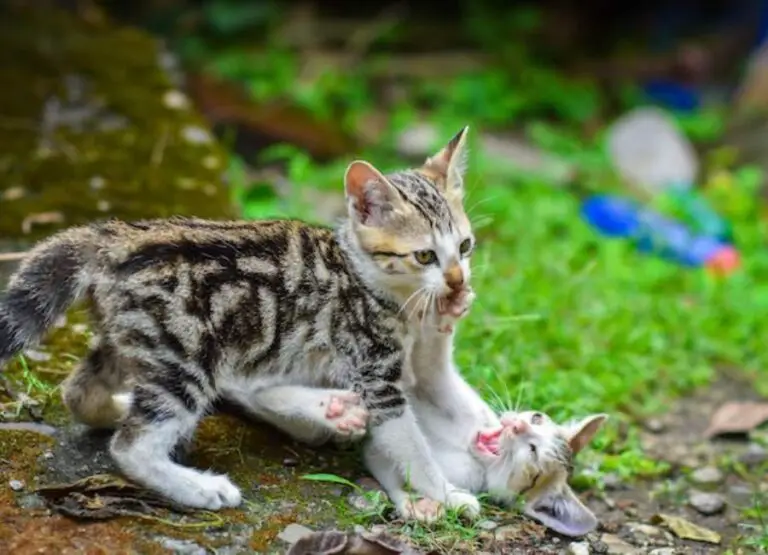How Do You Discipline a Kitten: 11 Right & Wrong Ways

How do you discipline a kitten is a common question among new cat parents, with my years of living with cats I will be discussing it.
I will highlight some common right ways to discipline a kitten and also outline the wrong ways to discipline a kitten so keep reading.
Kittens misbehave for many reasons some of which can be corrected easily and others may take longer.
So, let’s discuss…
How Do You Discipline a Kitten
Here are a few of the most frequent and effective ways to train a kitten:
1. Set clear rules for kittens to follow
It’s critical that you teach your kitten all there is to know about your home from the moment it arrives.
Say “no” and gently take your cat away from the table by the collar each time it defies your home rule, such as not allowing it to sit beneath the supper table during meals.
It’s critical that you and your family members be on the same page when it comes to implementing your kitty home rules.
Make a list of pet-related home rules and post it somewhere where everyone in your family can see it to avoid sending your cat mixed messages.
Here are examples of pet rules:
- No jumping on kitchen cabinets.
- No potty outside the litter box.
- Begging for food should not be encouraged.
- No jumping on TV stands.
- No scratching of furniture.
- Always scratch using that scratch post.
- No skipping of mealtimes.
- No eating on the floor.
- Don’t follow me into the bathroom, etc.
If you set clear rules for your kitten and teach him to follow them, there will be no room for discipline.
2. Teach the kitten a clear stop word or stop sign
It’s important to remember that kittens aren’t human beings who can understand a variety of word combinations.
Simply create a stop sign or utter “NO” before or during the unpleasant conduct to use the stop word.
Ascertain that your kitty understands the meaning of “NO” and relates it with the word “halt.”
It’s simple; don’t make things more difficult by combining long phrases since your cat might not know when to stop.
If you say “NO” a lot when you don’t mean it, your kitty will associate it with bad behavior and stop saying it.
Make sure your kitten understands your stop word or sign and actually associates it with halting their actions.
3. Give the kitten timeout in the act, not after the act
Give your cat a time out if it is hyperactive, harassing another pet, or disregarding your orders.
A time-out option is to employ social isolation as a kind of negative reinforcement for inappropriate behavior, which works particularly effectively for sociable animals such as cats.
The time-out should be held in a dull, unappealing location (such as the laundry room) and should be brief enough for your kitty to remember what it’s missing and not adjust to its new surroundings.
The duration of a kitten timeout should not exceed 60 seconds.
It may be necessary to repeat the method multiple times before your kitty realizes that its time has come as a result of certain behavior.
Don’t give your kitten an unnecessary timeout, make you do the timeout in the act, not after any unwanted behaviors.
4. Use a firm voice tone in making corrections
Kittens are stubborn by nature, and employing a soothing tone to persuade them to quit will not help.
Make sure your kitten knows how to respond to different voice tones so that they know what each tone signifies.
As a consequence, whenever you want your cat to stop doing anything, use a firm voice.
Say something loud like “ouch” or a similar phrase to surprise your kitty and stop any harsh behavior.
This works well for kittens who are aggressive towards humans and may bite or grip your arm or leg.
5. Consistently insist on good behavior from the kitten
Instead of giving up when your kitten refuses to follow your lead, it’s vital to keep your determination and insist on doing the right thing at all times.
In the long run, switching modes or action plans may assist, but being consistent and focused provides faster outcomes.
Positive behavior should be rewarded heavily in order to foster long-term relationships that your kitten will seek out.
Praise, caressing, food, and your kitten’s favorite toys may all be used to encourage good behavior.
Trainers may utilize clickers, which make a characteristic sound followed by a reward when a cat performs something exceptionally well.
6. Address the kitten’s unwanted behaviors in the act
When you come out of your room and notice your cat doing anything you don’t want, stop him right away and redirect his attention.
If you punish your kitten after the act or later in the day, he will have no idea what the problem is or what he did.
As a consequence, rather than reprimanding your kitty after the fact, do so while you catch him in the act.
7. Make sure you control the kitten meal time
Kittens should be fed the same amount of food at the same time every day for both discipline and health reasons.
Ask your kitty to sit before placing its food bowl in front of it to demonstrate your order.
Keep the food dish in your hand and say “no” until your kitty accepts to sit.
Reinforce this guideline every mealtime to teach your kitty that eating needs calm and well-behaved behavior.
Ensure that your kitten eats at regular intervals and that mealtimes are well-managed.
If you can control your kitten during mealtime, then you have total control of your kitten’s behavior.
8. Make sure you reward the kitten’s submissive behavior
Rewarding submissive behavior will benefit both you and your kitty.
Teaching your kitty to respect you as the alpha should be a pleasurable experience.
Encourage positive conduct at all times, but don’t force your kitten to show affection.
Grooming and praising your cat is one way to show him that you care.
Touching, caressing, and holding your pet’s paws on a regular basis will assist him in gaining control while also allowing him to enjoy cuddling time.
9. Use a water spray bottle for stubborn kitten
Several cat owners employ this strategy; however, I do not recommend it, not because it is ineffective, but because I believe it may have harmful consequences.
If your cat is somewhere or doing something they shouldn’t be, give them a quick spray. After a few instances, simply reaching for the spray bottle is likely to prevent the negative behavior.
Spraying water in your kitten’s face will cause him to come to a halt and walk away, but it may have a negative impact on your connection with him.
Despite its widespread use, I am opposed to it; instead, I always argue for positive reinforcement over negative reinforcement.
10. Shake a noisy can to district your kitten
This is very beneficial for kitties that enjoy climbing on top of cupboards and other places.
You may even use it to keep your kitten from exploring about in certain areas.
It also works if you want to keep your cat away from your houseplants.
Collect a few empty drink cans and stack them one on top of the other such that just minor touch causes them to wobble.
When your cat approaches and causes them to wobble for the first time, the noise will be enough to scare it away.
Remember to perform this activity 1-2 more times till the cat understands.
You won’t have to do this more than five times for even the most obstinate kitten.
Shake a can with pennies in it to scare your cat if you notice it jumping on the countertops or wherever it shouldn’t be.
11. Remain consistent in making corrections
Consistency is the key to disciplining your kitten since your cat will associate some unwanted action with undesirable behaviors within a short period of time.
Let’s say you let your kitty jump on the sink one day and didn’t stop it, and then the next day your kitten jumps on the sink, and you attempt to stop it.
This will just confuse your cat, and he will choose to fulfill his own desires over yours.
So, if you want your kitten to stop jumping on the sink, stop him every time he does it, and don’t break the chain until he identifies it with bad behavior.
How to prevent bad behaviors in kittens
Here is some set of the things that will help prevent bad behaviors in your kitten:
- Make good behavior extremely rewarding.
- Socialize your kitten early.
- Understand that your cat may not actually be misbehaving.
- Never shout or yell at your kitten.
- Learn what disciplinary actions will not work.
- Bond with your cat in fun and rewarding ways.
- Provide your kitten with basic needs.
- Make the bad behavior undesirable or impossible.
- Learn the medical reasons why kittens demonstrate unwanted behavior.
- Learn the behavioral issues that could be causing your kitten’s bad behavior.
- Provide early obedience training sessions for your kitten.
- Understand that your kitten may not actually be misbehaving.
- Manage your kitten’s claws.
- Set boundaries for your kitten jumping.
- Stopping attention-seeking disobedience behaviors.
Wrong ways to discipline a kitten
Here are some typical mistakes to avoid when it comes to training your kitten:
- As a kind of punishment, don’t shout at your kitten.
- As a punishment, do not scold or harm your kitten.
- It’s not a good idea to pull your kitten’s tail.
- As a kind of punishment, never drive with your cat in your arms.
- Never smash your kitten’s mouth into its excrement or urine as punishment.
- Remember to clean your kitten’s water bowls; don’t leave them unattended as a form of punishment.
- Inspect your kitten’s litter box every day, and never refuse to clean it as a form of punishment.
- As a kind of punishment, never let your kitten alone in the house for an extended period of time.
- As a punishment, your kitten should never be tossed out the window.
- As a kind of punishment, don’t let your cat alone in the dark.
I hope your question How Do You Discipline a Kitten was answered!






